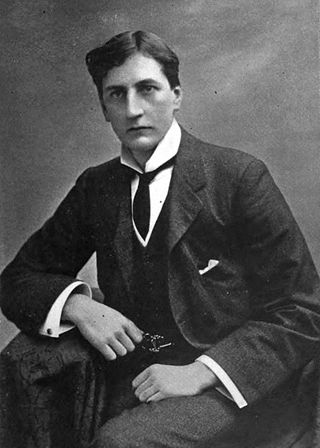
The Secret Adversary is the second published detective fiction novel by British writer Agatha Christie, first published in January 1922 in the United Kingdom by The Bodley Head and in the United States by Dodd, Mead and Company later in that same year. The UK edition retailed at seven shillings and sixpence (7/6) and the US edition at $1.75.

Edward Phillips Oppenheim was an English novelist, a prolific writer of best-selling genre fiction, featuring glamorous characters, international intrigue and fast action. Notably easy to read, they were viewed as popular entertainments. He was featured on the cover of Time magazine in 1927.

Alfred Edward Woodley Mason was an English author and Liberal Party Member of Parliament. He is best remembered for his 1902 novel of courage and cowardice in wartime, The Four Feathers, and is also known as the creator of Inspector Hanaud, a French detective who was an early template for Agatha Christie's famous Hercule Poirot.

Clara Margery Melita Sharp was an English writer of 25 novels for adults, 14 children's novels, four plays, two mysteries, and numerous short stories. Her best-known work is The Rescuers series about a heroic mouse named Miss Bianca and her partner Bernard, which was later adapted into the animated feature film The Rescuers (1977) – and a sequel, The Rescuers Down Under (1990) – by Walt Disney Productions.
Edgar Wallace (1875–1932) was a British novelist, playwright and screenwriter whose works have been adapted for the screen on many occasions. His films fall into two categories, British adaptations and the German "Krimi" films.

Reginald Evelyn Peter Southouse-Cheyney was a British crime fiction writer who flourished between 1936 and 1951. Cheyney is perhaps best known for his short stories and novels about agent/detective Lemmy Caution, which, starting in 1953, were adapted into a series of French movies, all starring Eddie Constantine. Another popular creation was the private detective Slim Callaghan who also appeared in a series of novels and subsequent film adaptations.
At the Villa Rose is a 1930 British mystery film directed by Leslie S. Hiscott and starring Norah Baring, Richard Cooper and Northern Irish Actor Austin Trevor. It marked Trevor's screen debut. It was released in the United States under the alternative title of Mystery at the Villa Rose.
The Passing of Mr. Quin is a 1928 British mystery film which was co-directed by Leslie S. Hiscott and Julius Hagen, starring Clifford Heatherley, Mary Brough and Ursula Jeans. The film was based on the short story The Coming of Mr. Quin, part of the collection The Mysterious Mr. Quin, which was written by Agatha Christie. It was the first British film to be made of one of Christie's works. The short story was adapted by Hiscott, who would in 1931 direct Alibi, the first film to feature Christie's more well known Belgian detective Hercule Poirot. The film was made at Twickenham Studios in London.
Teddy Arundell was a British film actor of the silent era.
Annie Esmond was a British stage and film actress.

The Clue of the New Pin is a 1961 British second feature ('B') crime film directed by Allan Davis and starring Paul Daneman, Bernard Archard and James Villiers. The screenplay was by Philip Mackie, based on the 1923 Edgar Wallace novel of the same title which was previously filmed in 1929. It is part of the series of Edgar Wallace Mysteries films made at Merton Park Studios from 1960 to 1965.

Lewis Dayton was a British actor who appeared in a number of films during the silent and early sound eras, largely in supporting roles but occasionally in the male lead.
The Yellow Claw is a 1921 British silent crime film directed by René Plaissetty and starring Sydney Seaward, Arthur M. Cullin and Harvey Braban. The film was shot partly at Cricklewood Studios and ran 68 minutes. It was based on the 1915 novel The Yellow Claw by Sax Rohmer, in which a French detective battles a notorious master criminal named Mr. King.
The Mystery of Mr. Bernard Brown is a 1921 British silent mystery film directed by Sinclair Hill and starring Ruby Miller, Annie Esmond and Clifford Heatherley. It was made by Stoll Pictures, and based on an 1896 novel The Mystery of Mr. Bernard Brown by E. Phillips Oppenheim.
The Mystery of Mr. Bernard Brown may refer to:

Ruby Miller was a British stage and film actress. Originally one of George Edwardes’ ‘Gaiety Girls’, she was the subject of TV's This is Your Life in 1962. In June 1966 she appeared in the final ABC production of the popular series Thank Your Lucky Stars with a rendition of the song "Stop and Think".

The Night Club Queen is a 1934 British musical mystery film directed by Bernard Vorhaus and starring Mary Clare, Jane Carr and Lewis Shaw.

Clue of the Twisted Candle is a 1960 British second feature crime film directed by Allan Davis and starring Bernard Lee, David Knight and Francis de Wolff. The screenplay was by Philip Mackie, based on the 1918 Edgar Wallace novel of the same title. It is part of the series of Edgar Wallace Mysteries films made at Merton Park Studios from 1960 to 1965.
The Terror is a 1927 mystery thriller play by the British writer Edgar Wallace. It is based on Wallace's 1926 novel The Black Abbot.

Clue of the Silver Key is a 1961 British second feature ('B') crime film directed by Gerard Glaister and starring Bernard Lee, Lyndon Brook and Finlay Currie. The screenplay was by Philip Mackie based on the 1930 Edgar Wallace novel of the same title. It is part of the series of Edgar Wallace Mysteries films made at Merton Park Studios from 1960 to 1965.











